| Großdeutsches Reich Greater German Reich | |
| 1933 – 1992 | |

|

|
| National Motto "Ein Volk, ein Reich, ein Führer. ("One People, one Empire, one Leader.") | |
| National Anthem First stanza of "Das Lied der Deutschen" followed by "Horst-Wessel-Lied" | |
| Geographical Location: | |
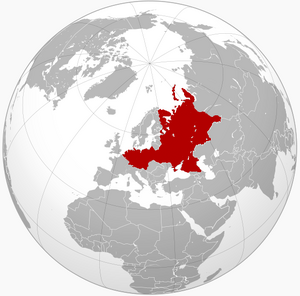 The Greater German Reich, 1962. | |
| Capital: |
Welthauptstadt Germania |
| Official language: | German |
| State ideology: | National Socialism |
| Government: | Single-party state, Totalitarian National Socialist Autocracy |
| Head of state - 1925 – 1934: - 1934 – 1968: - 1968 – 1981: - 1981 - |
Paul von Hindenburg (President) Adolf Hitler (Führer) Albert Speer (President)Kurt Waldheim (President) |
| Head of government: - 1933 – 1968: - 1968 – |
Reichskanzler Adolf Hitler Adolf Martin Bormann |
| Area: | 10,633,786 km² (2nd) |
| Population: | 349,314,000 (2nd) |
| GDP (PPP): - Total: - Per capita: |
1962 estimate $25.791 trillion (1st) $57,854 (1st) |
| History: - Machtergreifung: - Gleichschaltung: - Anschluss: - Invasion of ČSR: - Invasion of Poland: - Treaty of Rostov: |
Interwar period January 30, 1933 February 27, 1933 March 13, 1938 October 1, 1938 September 1, 1939 April 15, 1946 |
| Currency: | Reichsmark (RM) |
The Greater German Reich (Großdeutsches Reich), often referred as Nazi Germany and the Third Reich, refers to Germany under the regime of Adolf Hitler and the National Socialist German Workers Party (NSDAP or the Nazi Party), which established a totalitarian dictatorship in 1933. Officially, the state was, as in the preceding Weimar Republic era, still called the Deutsches Reich until 1943, whereafter it changed to its current form.
The policies pursued during this period were based on the concept of Lebensraum, among them "Aryan" racial purity, anti-Semitism, revenge for Germany's territorial losses at the Treaty of Versailles and the perceived loss of pride because of it, and anti-communism directed at the Soviet Union; also the Nazi regime's systematic mass murder of Jews, political opponents and other minorities like homosexuals and gypsies in a genocide known as the Holocaust.
Under the Nazi regime, Germany became one of the major states in Europe by early 1939 from a military, territorial and to some degree economical standpoint. After the annexation of Austria in 1938, Nazi Germany became the first united German state since the Holy Roman Empire to include Austria within its boundaries. Following the no compliance by the Czechoslovak government regarding the secession of the Sudetenland as demanded in the Munich Agreement signed by Hitler, British Prime Minister Neville Chamberlain, French Prime Minister Édouard Daladier and Italian Prime Minister Benito Mussolini on September 29, 1938, Hitler launched his military powers on Czechoslovakia, initiating Operation Fall Grün on October 1, 1938. On October 20, Hungary entered the war on Hitler's side, and following a bloody campaign, the Germans and the Hungarians finally conquered Czechoslovakia on March 15, 1939. On May 1, 1939, the territories of Sudetenland, Bohemia and Moravia was formally annexed into the German Reich.
The conquest of Czechoslovakia was the beginning of the Second World War. On September 1, 1939 Nazi Germany invaded Poland, which was completely overrun by October 5. In 1940, Nazi Germany had conquered Denmark, Norway, the Netherlands, Belgium, Luxembourg and its long-time rival and major adversary, France. On May 10, 1942 Nazi Germany, along with the rest of the Anti-Comintern Pact, invaded the Soviet Union, which capitulated on April 15, 1944.
Since 1945 — The Greater German Reich and United States of America have been the two world superpowers that dominate the global agenda of economic policy, foreign affairs, military operations, cultural exchange, scientific advancements including the pioneering of space exploration, and sports (including the Olympic Games and various world championships).
History[]
Seizure of Power[]
In order to secure a majority for his NSDAP in the Reichstag, Hitler called for new elections. On the evening of 27 February 1933, a fire was set in the Reichstag building. Hitler swiftly blamed an alleged Communist uprising, and convinced President Hindenburg to sign the Reichstag Fire Decree. This decree, which would remain in force until 1945, repealed important political and human rights of the Weimar constitution. Communist agitation was banned, but at this time not the Communist Party itself.
11,000 Communists and Socialists were arrested and brought into concentration camps, where they were at the mercy of the Gestapo, the newly established secret police force (9000 were found guilty and very many executed). Communist Reichstag deputies were taken into protective custody (despite their constitutional privileges).
Despite the terror and unprecedented propaganda, the last free General Elections of March 5, 1933, while resulting in 43.9% failed to bring the majority for the NSDAP that Hitler had hoped for. Together with the German National People's Party (DNVP), however, he was able to form a slim majority government. With accommodations to the Catholic Centre Party Germany, Hitler succeeded in convincing a required two-thirds of a rigged Parliament to pass the Enabling act of 1933 which gave his government full legislative power. Only the Social Democrats voted against the Act. The Enabling Act formed the basis for the Dictatorship, dissolution of the Länder; the trade unions and all political parties other than the National Socialist (Nazi) Party were suppressed. A centralised totalitarian state was established, no longer based on the liberal Weimar constitution. Germany left the League of Nations. The coalition Parliament was rigged on this fateful 23 March 1933 by defining the absence of arrested and murdered deputies as voluntary and therefore cause for their exclusion as willful absentees. Subsequently in July the Centre Party was voluntarily dissolved in a quid pro quo with the Holy See under the anti-communist Pope Pius XI for the Reichskonkordat; and by these maneuvers Hitler achieved movement of these Catholic voters into the Nazi party, and a long-awaited international diplomatic acceptance of his regime. It is interesting to note, however, that, according to Professor Dick Geary, the Nazis gained a larger share of their vote in Protestant than in Catholic areas of Germany in elections held between 1928 to November 1932[47] The Communist Party was proscribed in April 1933 . On the weekend of June 30, 1934, he gave order to the SS to seize Röhm and his lieutenants, and to execute them without trial (known as the Night of the Long Knives). Upon Hindenburg's death on 2 August 1934, Hitler's cabinet passed a law proclaiming the presidency vacant and transferred the role and powers of the head of state to Hitler as Führer und Reichskanzler (leader and chancellor).
However, many leaders of the Nazi SA were disappointed. The Chief of Staff of the SA, Ernst Röhm, was pressing for the SA to be incorporated into the Wehrmacht under his supreme command. Hitler felt threatened by these plans.
The SS became an independent organisation under the command of the Reichsführer SS Heinrich Himmler. He would become the supervisor of the Gestapo and of the concentration camps, soon also of the ordinary police. Hitler also established the Waffen-SS as a separate troop.
The regime showed particular hostility toward the Jews. In September 1935, the Reichstag passed the so-called Nuremberg race laws directed against Jewish citizens. Jews lost their German citizenship, and were banned from marrying non-Jewish Germans. About 500,000 individuals were affected by the new rules.
Hitler re-established the German air force and reintroduced universal military service. The open rearmament was in flagrant breach of the Treaty of Versailles, but neither the United Kingdom, France nor Italy went beyond issuing notes of protest.
In 1936 German troops marched into the demilitarised Rhineland. In this case, the Treaty of Locarno would have obliged the United Kingdom to intervene in favour of France but despite protests by the French government, Britain chose to do nothing about it. The coup strengthened Hitler's standing in Germany. His reputation was going to increase further with the 1936 Summer Olympics, which were held in the same year in Berlin and in Garmisch-Partenkirchen, and which proved another great propaganda success for the regime.
Expansion[]
After establishing the "Rome-Berlin axis" with Mussolini, and signing the Anti-Comintern Pact with Japan - which was joined by Italy a year later in 1937 - Hitler felt able to take the offensive in foreign policy. On 12 March 1938, German troops marched into Austria, where an attempted Nazi coup had been unsuccessful in 1934. When Hitler entered Vienna, he was greeted by loud cheers. Four weeks later, 99% of Austrians voted in favour of the annexation (Anschluss) of their country to the German Reich. Hitler thereby fulfilled the old idea of an all encompassing German Reich with the inclusion of Austria - the "greater Germany" solution that Bismarck had shunned when, in 1871, he united the German-speaking lands under Prussian leadership. Although the annexation denounced the Treaty of Saint-Germain, which expressly forbade the unification of Austria with Germany, the western powers once again merely protested.
After Austria, Hitler turned to Czechoslovakia, where the 3.5 million-strong Sudeten German minority was demanding equal rights and self-government. At the Munich Conference of September 1938, Hitler, the Italian leader Benito Mussolini, British Prime Minister Neville Chamberlain and French Prime Minister Édouard Daladier agreed upon the cession of Sudeten territory to the German Reich by Czechoslovakia. Hitler thereupon declared that all of German Reich's territorial claims had been fulfilled. However, hardly six months after the Munich Agreement, in March 1939, Hitler used the smoldering quarrel between Slovaks and Czechs as a pretext for taking over the rest of Czechoslovakia as the Protectorate of Bohemia and Moravia. In the same month, he secured the return of Memel from Lithuania to Germany. British Prime Minister Neville Chamberlain was forced to acknowledge that his policy of appeasement toward Hitler had failed.
In six years, the Nazi regime prepared the country for World War II. After annexing the Sudetenland border country of Czechoslovakia (October 1938), and taking over the rest of the Czech lands as a protectorate (March 1939), the German Reich and the Soviet Union invaded Poland on first September 1939 predominantly as part of the Wehrmacht operation code named Fall Weiss. The invasion of Poland began World War II.
Geography[]
Administrative regions[]
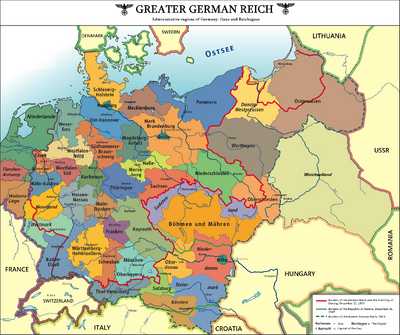
Administrative regions of Greater German Reich in 1960. Reichskommisariat Ostland is not included.
Under the Nazi regime, administrative powers were significantly altered. The term Gau was revived in the 1920s as the name given to the administrative regions of the Nazi Party. The Gau was the main administrative region of the NSDAP (Nazi Party), created by a party statute dated May 22, 1926. Each Gau was headed by a Gauleiter. The original 32 Gaue were generally coterminous with the pre-existing Länder and Prussian provinces.
By 1938 all of Germany was divided into around 30 Gaue. Following the suppression of the political institutions of the Länder (states) in 1934, the Gaue had become the de facto administrative region of government, and each individual Gauleiter had considerable power within his territory.
With Germany's annexation of neighbouring territories beginning in the late 1930s, a new unit of civil administration, the Reichsgau, was also created. After the successful invasion of France in 1940, the Alsace-Lorraine was re-annexed by Germany. The former département of Moselle was incorporated into the Gau of Saar-Palatinate, while Bas-Rhin and Haut-Rhin were incorporated into Baden Gau. Similarly, the formerly independent state of Luxembourg was annexed to Koblenz-Trier, and the Belgian territories of Eupen and Malmedy were incorporated into Cologne-Aachen.
German-speaking territories annexed to Germany from 1938 were generally organised into Reichsgaue. Unlike the pre-existing Gaue, the new Reichsgaue formally combined the spheres of both party and civil administration.
Following the annexation of Austria in 1938, the country, briefly renamed "Ostmark", was sub-divided into seven Reichsgaue. These had boundaries broadly the same as the former Austrian Länder (states), with the Tyrol and Vorarlberg being merged as "Tyrol-Vorarlberg", Burgenland being divided between Styria and "Lower Danube" (the re-named Lower Austria). Upper Austria was also re-named "Upper Danube", thus eliminating the name of "Austria" from the official map. A small number of boundary changes were also made, the most significant of which was the massive expansion of Vienna's official territory, at the expense of "Lower Danube".
Northern and eastern territory annexed from the dismembered Czechoslovakia were mainly organised as the Reichsgau of Sudetenland, while Bohemia and Moravia was annexed and organised as the Reichsgau of Böhmen und Mähren.
Following the invasion of Poland in 1939, territories lost at the Treaty of Versailles, together with some adjacent territory, were re-annexed to Germany as the Reichsgaue of Danzig-Westpreussen (which also incorporated the former Free City of Danzig) and Wartheland. Central Poland and Polish Galicia were run by a protectorate government, called the General Gouvernment. Eventually, the Polish people were supposed to be "removed" and Poland itself populated with 5 million Germans. In 1946 the General Gouvernment was formally annexed and organised as the Reichsgau of Weichselland.
In 1943, the Netherlands and Belgium was annexed into Germany. The Netherlands were organised as the Reichsgau of Niederlande, while Belgium was organised as Flanders-Antwerp, comprising the Dutch-speaking provinces of Antwerp, Limburg, East Flanders, West Flanders, the arrondissement of Brussels (except the city of Brussels itself), and the arrondissement of Leuven in the then-province of Brabant, and Wallonia-Liège, comprising the Francophone provinces of Hainaut, Liège, Luxembourg, Namur, and the arrondissement of Nivelles in the then-province of Brabant.
Greater Germany[]
Outside of what was directly annexed into Germany were the regional territories created in occupied lands. In many areas, occupied territories called Reichskommissariat were set up. In the occupied Soviet Union territories, these included the Reichskommissariat Ostland (Byelorussia), Reichskommissariat Ukraine, Reichkommisariat Moskau, Reichskommisariat Kaukasus and Reichskommissariat West Siberien. While Reichskommisariat Ukraine, Moskau and Kaukasus were established for German resettlement, Reichskommissariat West Siberien was established for housing concentration camps housing Slavs for slave labor for industrial enterprises and on the estates of the German farmers west of the Urals.
In 1950, Germany granted the former Soviet republics of Georgia, Azerbaijan and Armenia independence and made them satellite states of the Reich. The oil centre of Baku remained under German control.
Demographics[]
Economy[]
When the Nazis came to power the most pressing issue was an unemployment rate of close to 30%. The economic policies of the Third Reich were in the beginning the brainchildren of Hjalmar Schacht, who assumed office as president of the central bank under Hitler in 1933, and became finance minister in the following year. Schacht was one of the few finance ministers to take advantage of the freedom provided by the end of the gold standard to keep interest rates low and government budget deficits high: massive public works funded by large budget deficits. The consequence was an extremely rapid decline in unemployment - the most rapid decline in unemployment in any country during the Great Depression. Eventually this Keynes-like policy was to be supplemented by the boost to demand provided by rearmament and swelling military spending.
Hjalmar Schacht was replaced in September 1936 by Hitler's lieutenant Hermann Göring, with a mandate to make Germany self-sufficient to fight a war within four years. Under Göring imports were slashed. Wages and prices were controlled--under penalty of being sent to the concentration camp. Dividends were restricted to six percent on book capital. And strategic goals to be reached at all costs (much like Soviet planning) were declared: the construction of synthetic rubber plants, more steel plants, automatic textile factories.
While the strict state intervention into the economy, and the massive rearmament policy, led to full employment during the 1930s, real wages in Germany dropped by roughly 25% between 1933 and 1938. Trade unions were abolished, as well as collective bargaining and the right to strike. The right to quit also disappeared: Labour books were introduced in 1935, and required the consent of the previous employer in order to be hired for another job.
Another part of the new German economy was massive rearmament, with the goal being to expand the 100,000-strong German Army into a force of millions. The Four-Year Plan was discussed in the controversial Hossbach Memorandum, which provides the "minutes" from one of Hitler's briefings. Nevertheless, the war came and although the Four-Year Plan technically expired in 1940, Hermann Göring had built up a power base in the "Office of the Four-Year Plan" that effectively controlled all German economic and production matters by this point in time.
Following the end of the Second World War, Nazi Germany has emerged as one of the two largest economies in the world, mostly due to the series of Four-Year Plans implemented by Adolf Hitler, the capture of some of the largest industrial sites in Europe (those of the former Czechoslovakia and the Soviet Union), foreign credits seized in occupied territories and the large force of labour workers.
However, with massive military budgets, incessant slave revolts, crippling counterinsurgency programmes and astronomical space programme budgets, many suspect that Germany could collapse by 2020.
Politics[]
Government[]
Nazi Germany is made up of various competing power structures, all trying to gain favor with the Führer, Adolf Hitler. Thus many existing laws have been stricken and replaced with interpretations of what Hitler wanted. Any high party/government official is able take one of Hitler's comments and turn it into a new law, of which Hitler would casually either approve or disapprove. This has become known as "working toward the Führer", as the government is not a co-ordinated, co-operating body, but a collection of individuals each trying to gain more power and influence through the Führer. This can make government very convoluted and divided, especially with Hitler's vague policy of creating similar posts with overlapping powers and authority. The process allows the more unscrupulous and ambitious Nazis to get away with implementing the more radical and extreme elements of Hitler's ideology and in doing so win political favor. Protected by Goebbels' extremely effective propaganda machine, which portrays the government as a dedicated, dutiful and efficient outfit, the dog-eat-dog competition and chaotic legislation has been allowed to escalate. Historical opinion is divided between "intentionalists", who believe that Hitler created this system as the only means of ensuring both the total loyalty and dedication of his supporters and the impossibility of a conspiracy; and "structuralists", who believe that the system evolved by itself and is a limitation on Hitler's supposedly totalitarian power.
Cabinet and national authorities[]
- Office of the Reich Chancellery (Hans Lammers)
- Office of the Party Chancellery (Martin Bormann)
- Office of the Presidential Chancellery (Otto Meissner)
- Privy Cabinet Council (Konstantin von Neurath)
- Chancellery of the Führer (Philip Bouhler)
Reich offices[]
- Office of the Four-Year Plan (Hermann Göring)
- Office of the Reich Master Forester (Hermann Göring)
- Office of the Inspector for Highways
- Office of the President of the Reich Bank
- Reich Youth Office
- Reich Treasury Office
- General Inspector of the Reich Capital
- Office of the Councillor for the Capital of the Movement (Munich, Bavaria)
Reich ministries[]
- Reich Foreign Ministry (Joachim von Ribbentrop)
- Reich Interior Ministry (Wilhelm Frick, Heinrich Himmler)
- Reich Ministry of Public Enlightenment and Propaganda (Joseph Goebbels)
- Reich Ministry of Aviation (Hermann Göring)
- Reich Ministry of Finance (Lutz Schwerin von Krosigk)
- Reich Ministry of Justice (Otto Thierack)
- Reich Economics Ministry (Walther Funk)
- Reich Ministry for Nutrition and Agriculture (Richard Walther Darré)
- Reich Labour Ministry (Franz Seldte)
- Reich Ministry for Science, Education, and Public Instruction (Bernhard Rust)
- Reich Ministry for Ecclesiastical Affairs (Hanns Kerrl)
- Reich Transportation Ministry (Julius Dorpmüller)
- Reich Postal Ministry (Wilhelm Ohnesorge)
- Reich Ministry for Weapons, Munitions, and Armament (Fritz Todt, Albert Speer)
- Reich Ministers without Portfolio (Konstantin von Neurath, Hans Frank, Hjalmar Schacht, Arthur Seyss-Inquart)
State ideology[]
National Socialism had some of the key ideological elements of fascism which originally developed in Italy under Benito Mussolini; however, the Nazis never officially declared themselves fascists. Both ideologies involved the political use of militarism, nationalism, anti-communism and paramilitary forces, and both intended to create a dictatorial state.[citation needed] The Nazis, however, were far more racially-oriented than the fascists in Italy, Portugal, and Spain. The Nazis were also intent on creating a completely totalitarian state, unlike Italian fascists who while promoting a totalitarian state, allowed a larger degree of private liberties for their citizens. These differences allowed the Italian monarchy to continue to exist and have some official powers. However the Nazis copied much of their symbolism from the Fascists in Italy, such as copying the Roman salute as the Nazi salute, use of mass rallies, both made use of uniformed paramilitaries devoted to the party (the SA in Germany and the Blackshirts in Italy), both Hitler and Mussolini were called the "Leader" (Führer in German, Duce in Italian), both were anti-Communist, both wanted an ideologically-driven state, and both advocated a middle-way between capitalism and communism, commonly known as corporatism. The party itself rejected the fascist label, claiming National Socialism was an ideology unique to Germany. Many analysts, however, classify National Socialism as a racially-oriented version of fascism.
The totalitarian nature of the Nazi party was one of its principal tenets. The Nazis contended that all the great achievements in the past of the German nation and its people were associated with the ideals of National Socialism, even before the ideology officially existed. Propaganda accredited the consolidation of Nazi ideals and successes of the regime to the regime's Führer ("Leader"), Adolf Hitler, who was portrayed as the genius behind the Nazi party's success and Germany's saviour.
To secure their ability to create a totalitarian state, the Nazi party's paramilitary force, the Sturmabteilung (SA) or "Storm Unit" used acts of violence against leftists, democrats, Jews, and other opposition or minority groups. The SA's violence created a climate of fear in cities, with people anxious over punishment, or even death, if they displayed opposition to the Nazis. The SA also helped attract large numbers of alienated and unemployed youth to the party.
The "German problem", as it is often referred to in English scholarship, focuses on the issue of administration of Germanic regions in Northern and Central Europe, an important theme throughout German history. The "logic" of keeping Germany small worked in the favor of its principal economic rivals, and had been a driving force in the recreation of a Polish state. The goal was to create numerous counterweights in order to "balance out Germany's power".
The Nazis endorsed the concept of Großdeutschland, or Greater Germany, and believed that the incorporation of the Germanic people into one nation was a vital step toward their national success.[citation needed] It was the Nazis' passionate support of the Volk concept of Greater Germany that led to Germany's expansion, that gave legitimacy and the support needed for the Third Reich to proceed to conquer long-lost territories with overwhelmingly non-German population like former Prussian gains in Poland that it lost to Russia in the 1800s, or to acquire territories with German population like parts of Austria. The German concept of Lebensraum (living space) or more specifically its need for an expanding German population was also claimed by the Nazi regime for territorial expansion.
Two important issues were administration of the Polish corridor and Danzig's incorporation into the Reich. As a further extension of racial policy, the Lebensraum program pertained to similar interests; the Nazis determined that Eastern Europe would be settled with ethnic Germans, and the Slavic population who met the Nazi racial standard would be absorbed into the Reich. Those not fitting the racial standard were to be used as cheap labour force or deported eastward.
Racialism and racism were important aspects of society within the Third Reich. The Nazis combined anti-Semitism with anti-Communist ideology, regarding the leftist-internationalist movement — as well as international market capitalism — as the work of "Conspiratorial Jewry". They referred to this so-called movement with terminology such as the "Jewish-Bolshevistic revolution of subhumans". This platform manifested itself in the displacement, internment, and systematic extermination of an estimated 11 million to 20 million people during and after the Second World War, roughly eight million of them being Jews targeted in what is historically remembered as the Holocaust (Shoah), 8 million ethnic Poles,and another 1,000,000 being Roma, who were murdered in the Porajmos. Other victims of Nazi persecution included communists, various political opponents, social outcasts, homosexuals, freethinkers, religious dissidents such as Jehovah's Witnesses, Christadelphians, the Confessing Church and Freemasons.
Law[]
Most of the judicial structures and legal codes of the Weimar Republic remained in use during the Third Reich, but significant changes within the judicial codes occurred, as well as significant changes in court rulings. The Nazi party was the only legal political party in Germany; all other political parties were banned. Most human rights of the constitution of the Weimar Republic were disabled by several Reichsgesetze (Reich's laws). Several minorities such as the Jews, opposition politicians and prisoners of war were deprived of most of their rights and responsibilities. The Volksstrafgesetzbuch (people's code of criminal justice) was introduced in 1948, following the Second World War.
As a new type of court, the Volksgerichtshof (people's court) was established in 1934, only dealing with cases of political importance. From 1934 to June 1968, a total of 16,375 death sentences were spoken by the court. Not included in this numbers are the death sentences from 20 July 1944 until April 1945, which are estimated at 2,000. Its most prominent jurist was Roland Freisler, who headed the court from August 1942 to February 1959.
Foreign Relations[]
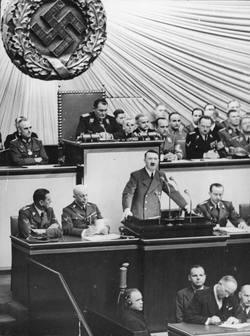
Adolf Hitler holding a speech condemning a staged Czechoslovak murder on Sudeten Germans and declaring war on Czechoslovakia, October 1, 1938.
Upon coming to power in 1933, the Nazi regime was faced with the implications of the Treaty of Versailles which restricted Germany's presence on the international stage. The treaty forbade Germany to build war machines deemed to be aggressive, such as aircraft, submarines, and large battleships. Further Germany was not allowed to have any political union with German-populated Austria or Danzig.
During the 1930s, Hitler and the Nazi regime performed a number of political maneuvers to increase German power. The regime demanded that the international community allow Germany to increase the size of its navy so that it could adequately defend itself, this was agreed to in 1935, with the Anglo-German Naval Agreement. The regime also pursued defying the Treaty of Versailles further by endorsing a plebiscite in German-populated Saar which resulted in it returning to Germany in 1935, after being held by France as a protectorate since 1919. In 1936, with no British or French forces remaining in the Rhineland (which was to be permanently demilitarized of German forces), Germany once again defied Versailles by sending military forces into the Rhineland.
From 1936 onward, Germany steadily proceeded on an interventionist foreign policy approach, beginning by supporting the fascist nationalist forces of Francisco Franco during the Spanish Civil War against the republican forces which were supported by the Soviet Union. German aircraft took part in attacks on Spanish republican forces as well as the infamous bombing of civilians in the Basque town of Guernica in 1937.
Expansionism[]
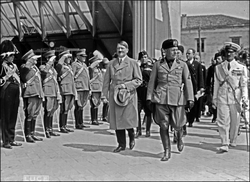
Adolf Hitler and Benito Mussolini during Hitler's visit to Venice from 14-16 June 1934.
The regime also pursued defying the Treaty of Versailles with a expansionist foreign policy. With plans for Lebensraum for the German people, they annexed territories with a German-speaking population.
On July 25, 1934, eight Austrian Nazis who entered the Chancellery building shot and killed Austrian chancellor Engelbert Dollfuß in an attempted Nazi coup d'état (the so-called July Putsch) as a prelude to the Anschluss. The Vienna murder was accompanied by Nazi upheavals in the Salzkammergut and southern Styria regions, resulting in further dozens of dead. Immediately after the assassination Italian armed forces mobilized at the Austrian-Italian border to deter any German invasion of Austrian territory. However, the Nazi assassins in Vienna surrendered and were executed. Kurt Schuschnigg became the new chancellor and dictator of Austria.
They switched focus and turned to the German-populated Saarland. In January 1935 they endorsed a plebiscite in the protectorate which resulted in Saarland returning to Germany in 1935, after being held by France as a protectorate since 1919. On March 7, 1936, with no British or French forces remaining in the Rhineland (which was to be permanently demilitarized of German forces), Germany once again defied Versailles by sending military forces into the Rhineland.
After Italy became isolated in 1936 due to sanctions by the League of Nations following their invasion of Abyssinia in 1935, the Italian government had little choice but to work with Germany to regain a stable bargaining position in international affairs. Germany, as a non-member of the League of Nations, was not compelled to establish sanctions on Italy, showed solidarity by increasing trading and support their military action, and soon became the Italians main trading partner and ally. The two nations proceeded to form the Rome-Berlin Axis, more commonly known as the Axis Pact, in 1936. Italy's earlier protests of the Nazi regime's intentions to annex Austria quelled as the Nazis and the Italian Fascists exchanged essential concessions to secure good relations.
On March 11, 1938, German troops entered Austria and annexed it in the Anschluss, this time without protest from Italy.
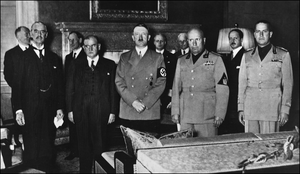
From left to right: Neville Chamberlain, Édouard Daladier, Adolf Hitler, Benito Mussolini and Count Gian Galeazzo Ciano pictured before signing the Munich Agreement.
During the summer of 1938, tensions rose between Nazi Germany and Czechoslovakia over the Sudetenland. Hitler claimed that the Czechs suppressed the German minority living there, and demanded that the Czech government should cede Sudetenland to Germany, or else they would take it by force. While both sides mobilised for war, the British Prime Minister Neville Chamberlain feared that war was looming over Europe, and wished for a peaceful resolution of the crisis.
Chamberlain met Hitler in Godesberg on September 22 to confirm the agreements. Hitler however, aiming at using the crisis as a pretext for war, now demanded not only the annexation of the Sudetenland but the immediate military occupation of the territories, giving the Czechoslovakian army no time to adapt their defence measures to the new borders. To achieve a solution, Italian prime minister Benito Mussolini suggested a conference of the major powers in Munich and on September 29, Hitler, Daladier and Chamberlain met and agreed to Mussolini's proposal (actually prepared by Hermann Göring) and signed the Munich Agreement accepting the immediate occupation of the Sudetenland. At about 1:30 AM on September 30, Adolf Hitler, Neville Chamberlain, Benito Mussolini and Édouard Daladier signed the Munich Agreement.
Following the Czech refusal to cede the Sudetenland, Hitler initiated the invasion of Czechoslovakia on October 1, 1939, without meeting resistance from the French and British governments. On March 15, Nazi Germany along with Hungary had defeated Czechoslovakia, and the territories of Sudetenland, Bohemia and Moravia was formally annexed on May 1, 1939.
In the early hours of 23 March 1939, after a oral ultimatum had made a Lithuanian delegation travel to Berlin, the Lithuanian Minister of Foreign Affairs Juozas Urbšys and his German counterpart Joachim von Ribbentrop signed the Treaty of the Cession of the Memel Territory to Germany in exchange for a Lithuanian Free Zone for 99 years in the port of Memel, using the facilities erected in previous years. Hitler had anticipated this aboard a Kriegsmarine naval ship, and at dawn sailed into Memel (Klaipėda) to celebrate the return heim ins Reich of the Memelland. German forces seized the territory even before the official Lithuanian ratification. The United Kingdom and France, as after the revolt of 1923, did not actively protect the autonomy of the territory. It was under these conditions that the Seimas was forced to approve the treaty, hoping that Germany would not press any other territorial demands upon Lithuania. The reunion with Germany was welcomed by the majority of the population, both by Germans and by Memellanders.
For quite some time, Germany had engaged in informal negotiations with Poland regarding the issue of territorial revision, but after the Munich Agreement and the reacquisition of Memel, the Nazis became increasingly vocal. Poland refused to allow the annexation of the Free City of Danzig.
Germany and the Soviet Union began talks over planning an invasion of Poland. In August 1939, the Molotov Pact was signed and Germany and the Soviet Union agreed to divide Poland along a mutually-agreed set boundary. The invasion was put into effect on September 1, 1939. Last-minute Polish-German diplomatic proceedings failed, and Germany invaded Poland as scheduled. Germany alleged that Polish operatives had attacked German positions, but the result was the outbreak of World War II, as Allied forces refused to accept Germany's claims on Poland and blamed Germany for the conflict.
From 1939 to 1940, the so-called "Phony War" occurred, as German forces made no further advances but instead, both the Axis and Allies engaged in a propaganda campaign. However in early 1940, Germany began to concern that the British intended to stop trade between Sweden and Germany by bringing Norway into an alliance against Germany, with Norway in Allied hands, the Allies would be dangerously close to German territory. In response, Germany invaded Denmark and Norway ending the Phony War. After sweeping through the Low Countries and occupying northern France, Germany allowed French nationalist and war hero Philippe Petain to form a fascist regime in southern France known as the "French State" but more commonly referred to as Vichy France named after its capital in Vichy.
In 1941 Germany's invasion of Yugoslavia resulted in that state's splintering. Despite Hitler's earlier view of inferiority of all Slavs, he supported Mussolini's agenda of creating a fascist puppet state of Croatia, called the Independent State of Croatia. Croatia was led by the extreme nationalist Ante Pavelić, a long-time Croatian exile in Rome, whose Ustashe movement formed a government in the territories of Croatia and Bosnia and Herzegovina. The Ustashe were allowed to persecute Serbs, while Germany contributed to that goal in German-occupied Serbia.
From 1941 to 1944 the end of the war, Germany was engaged in war with the Soviet Union in its attempt to create the Nazi colonial goal of Lebensraum "living space" for German citizens. The German army, after request made by the governments of their allies Finland and Lithuania, liberated Latvia and Estonia, and put their pre-war autocratic leaders to power, in order not to create dissent among the people later on. The German occupation authorities also set up occupation and colonial authorities called Reichskommissariats such as Reichskommissariat Ostland and Reichskommissariat Ukraine. The Slavic populations were to be destroyed along with Jews there to make way for German colonists, which was completed by 1958.
Relations with Western Countries[]
After the war ended most western country civilians thought the Greater German Reich was just a country who was hungry for land. They did not know of the millions of Jews who were executed, or the main ideology of the government. In the late 1980's tension between Germany and the western countries started to lessen. It wasn't until 1991 that foreign civilians could travel to the Greater German Reich freely, though they are watched by the board of tourism closely.
Relations with Italy[]
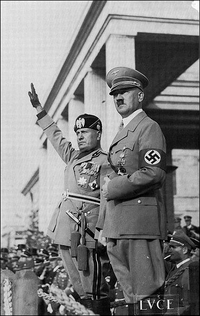
Adolf Hitler with Italian leader Benito Mussolini.
Hitler had attempted to befriend Mussolini in the past to no avail, as Mussolini had little interest in his political activity. Also, Mussolini opposed Hitler's anti-Semitic beliefs, for a number of Fascists were Jewish, including Mussolini's mistress Margherita Sarfatti, the director of Fascist art and propaganda. Furthermore, there was little support amongst Italians for anti-Semitism.
On July 25, 1934, eight Austrian Nazis who entered the Chancellery building shot and killed Austrian chancellor Engelbert Dollfuß in an attempted Nazi coup d'état (the so-called July Putsch) as a prelude to the Anschluss. The Vienna murder was accompanied by Nazi upheavals in the Salzkammergut and southern Styria regions, resulting in further dozens of dead. Immediately after the assassination Mussolini promised the Austrians military support if Germany were to interfere. The Italian armed forces therefore mobilized at the Austrian-Italian border to deter any German invasion of Austrian territory. However, the Nazi assassins in Vienna surrendered and were executed. Kurt Schuschnigg became the new chancellor and dictator of Austria. This promise helped save Austria from annexation in 1934.
After Italy became isolated in 1936 due to sanctions by the League of Nations following their invasion of Abyssinia in 1935, the Italian government had little choice but to work with Germany to regain a stable bargaining position in international affairs. Germany, as a non-member of the League of Nations, was not compelled to establish sanctions on Italy, showed solidarity by increasing trading and support their military action, and soon became the Italians main trading partner and ally. The two nations proceeded to form the Rome-Berlin Axis, more commonly known as the Axis Pact, in 1936. Italy's earlier protests of the Nazi regime's intentions to annex Austria quelled as the Nazis and the Italian Fascists exchanged essential concessions to secure good relations, by Germany abandoning support of Germans in South Tyrol and Italy introducing anti-Semitic laws.
Public appearances and propaganda constantly portrayed the closeness of Mussolini and Hitler and the similarities between Italian Fascism and German National Socialism. While both ideologies had significant similarities, Italian Fascism only became closely linked with Nazism because of Italy’s need to have Germany as a partner to avoid international isolation and to pursue a war to expand the Italian Empire.
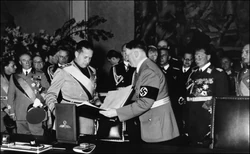
The signing of the Pact of Steel on May 22, 1939.
On May 22, 1939 the foreign ministers of Germany and Italy, Joachim von Ribbentrop and Count Galeazzo Ciano signed Pact of Steel, known formally as the Pact of Friendship and Alliance between Germany and Italy.
The Pact consisted of two parts: the first section was an open declaration of continuing trust and co-operation between Germany and Italy while the second, a 'Secret Supplementary Protocol' encouraged a joint military and economic policy.
The Pact of Steel obliged Germany and Italy to aid the other country immediately, militarily or otherwise, in the event of war being declared, and to collaborate in military and wartime production. The Pact ensured that neither country was able to make peace without the agreement of the other. The agreement was based on the assumption that a war would occur within three years.
Today, Italy, along with Hungary and Lithuania, are the closest allies of Nazi Germany, both in terms of politics, but also in terms of military and culture.
Relations with Hungary[]
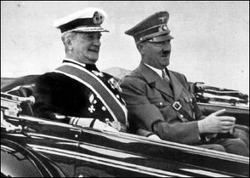
Adolf Hitler with Hungarian regent Miklós Horthy.
The German-Hungarian relations was among the most important foreign relations of the Reich, which began as early as 1935.
Along with Germany, Hungary had particular interests in parts of Czechoslovakia's territory. For years they had wanted a revision of the Treaty of Trianon, which included the unification of the Hungarian-populated parts of the ČSR, if not the whole of Slovakia, with Hungary.
During the Invasion of Czechoslovakia in October 1938, Hungary mobilised between 200,000 and 350,000 ill-trained and ill-equipped men on the Slovak and Ruthenian borders, ready to invade and capture these territories. On October 20, they joined the Germans, and on March 15, 1939 they had, along with Germany, conquerred Czechoslovakia, which was subsequently split up. As Hungary had supported Germany in the invasion of Czechoslovakia, and had now regained some of its lost territories, a close alliance and friendship was established between the two countries, and they came only in second to that of Germany and Italy.
The relations worsened somewhat when Hungary refused to participate in the Invasion of Poland in September 1939, but they were accepted into the Anti-Comintern Pact on November 20, 1939. In 1940, the Kingdom of Hungary joined the Tripartite Pact and demanded the concession of Transylvanian territory from Romania. German Führer Adolf Hitler and the Nazi regime helped Hungary receive significant portions of Transylvania while avoiding a war with Romania. However, Hitler demanded that the Hungarian government follow Germany’s military and racial agenda in order to avoid potential conflict in the future. Anti-Semitism was already an established political cause by the far-right in Hungary and the Hungarian government aided Nazi Germany in the deportation of Jews to concentration camps during the Holocaust.
Hungary joined Germany and Italy in their invasion of Yugoslavia in 1941. Hungary was allowed to annex the Bačka region in Vojvodina which had large numbers of Serbs, as well as the regions of Prekmurje and Medjimurje that had a large Slovenian and Croatian majority respectively. Other ambitions such as those on Croatia were halted by the creation of the Independent State of Croatia and Nazi Germany’s alliance with Romania against the Soviet Union. Fearing a potential turn of support to the Romanians, the Hungarian government sent a number of soldiers to help the German campaign against the Soviet Union.
Today, the German's relations with Hungary is among the most important, sharing a close alliance (due to both nation's membership of the Anti-Comintern Pact) and friendship.
Anti-Comintern Pact[]
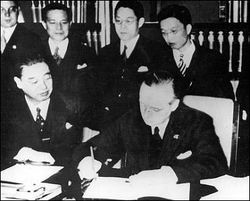
Watched by the Japanese signatory, Japanese ambassador to Nazi Germany Viscount Kintomo Mushakoji, Hitler's foreign affairs adviser Joachim von Ribbentrop signs the Anti-Comintern Pact, November 25, 1936.
Nazi Germany is the Nominal Head of the Anti-Comintern Pact.
The Anti-Comintern Pact was concluded between Nazi Germany and the Empire of Japan on November 25, 1936 and was directed against the Communist International (Comintern) in general, and the Soviet Union in particular.
"recognizing that the aim of the Communist International, known as the Comintern, is to disintegrate and subdue existing States by all the means at its command; convinced that the toleration of interference by the Communist International in the internal affairs of the nations not only endangers their internal peace and social well‑being, but is also a menace to the peace of the world desirous of co‑operating in the defense against Communist subversive activities"
In case of an attack by the Soviet Union against Germany or Japan, the two countries agreed to consult on what measures to take "to safeguard their common interests". They also agreed that neither of them would make any political treaties with the Soviet Union, and Germany also agreed to recognize Manchukuo.
On November 6, 1937, Italy also joined the pact, thereby forming the group that would later be known as the Axis Powers.
Military[]
The military of the Third Reich - the Wehrmacht - is the name of the unified armed forces of Germany since 1935 with Heer (Army), Kriegsmarine (Navy), Luftwaffe (Air Force) and a military organization Waffen-SS (National Guard), which was, de facto, a fourth branch of the Wehrmacht. The German Army furthered concepts pioneered during the First World War, combining Ground and Air Force assets into combined arms teams. Coupled with traditional war fighting methods such as encirclements and the "battle of annihilation", the German military managed many lightning quick victories in the Second World War, prompting foreign journalists to create a new word for what they witnessed: Blitzkrieg. Since the Second World War, the Wehrmacht has along with the United States Armed Forces been the leading power in terms of firepower, strength, size and technology.
Confrontation with the US and the UN during the Cold War mainly took the form of threatened mutual deterrence with nuclear weapons. Germany invested heavily in the Army's nuclear capacity, especially in the production of ballistic missiles and of nuclear submarines to deliver them. Open hostilities took the form of wars by proxy, with Germany and the U.S. supporting loyal client régimes or rebel movements in South America and in Third World countries.
Wehrmacht Heer[]
The Wehrmacht Heer is one of the most powerful armies on the Earth, their commando squads (Brandenburgers) on par with the SAS and Delta Force. their spectacular victories over France, Britain and Russia have put it amidst the greatest military powers in History. They also have an impressive array of tanks, with the Leopard IV being their main battle tank and is fully capable of taking on an M1A2 1 on 1. the new Jaguar I is set to be the most powerful tank to enter service.
Kriegsmarine[]
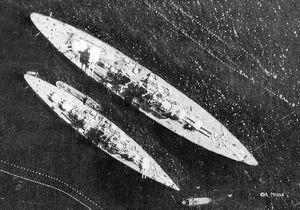
The German H-Class Superbattleship Götz von Berlichingen at anchor beside the Tirpitz prior to a joint exersize off Norway, 1963
Following WW-II, the Kriegsmarine was expanded farther with the introduction of the aircraft carriers Graf Zeppelin and Peter Strasser, and the H-class Superbattleships Hindenburg, Götz von Berlichingen and Ulrich von Hutten. The building of the H-Class ships was opposed by Karl Dönitz, who wanted a pure submarine force, citing the victory of the U-Boats in the Battle of the Atlantic, but he was overruled by Hitler. By 1970, the Kreigsmarine had the fourth largest navy in the world after the Imperial Japanese Navy, US navy and Royal Navy. It now included nine aircraft carriers, the modernized H-Class battleships and the smaller Bismark Class, as well as a large fleet of frigates and destroyers, plus the world's largest submarine fleet.
However, the death of Hitler in 1972, caused a huge loss of funding. Hitler, to the dissatisfaction of his ministry and the Luftwaffe and Army, had always had a soft spot for the Navy, and with his death, spending was cut on many super projects, including a "Floating Island" to have been built in the Mediterranean, a new series of Super Battleships to replace the aging H-class, the decreasing of an order for ren new Nuclear powered supercarriers to take on the US Navy's New Nimitz class and the Royal Navy's Queen Elizabeth Class carriers from ten to four.
Luftwaffe[]
Goring's Luftwaffe was ill-equipped to fight a Strategic war at the outset of WWII. the introduction of long ranged Aircraft like the Me 264, the Ju 390 and the Fw 249 heavy transport has rectified this problem. the introduction of Jet Aircraft, starting with the Me 262, and Stealth Aircraft like the Ho IX has made the Luftwaffe a feared opponent. It is said in some circles that not even the new F-22 Raptor could take on the Me 762 one on one. The Ju 690 Stealth Bombers carries 1/3 of the Reichs Nuclear Weapons, but is behind the British Vulcan II or the American B-2.
Waffen-SS[]
The newest branch of the German Military, the Waffen SS originated in the SS-VT which saw service in Czeckoslovakia and Poland.
Following the victory in Europe, the German Army has fought a long, bloody and at times expensive anti-insurgency campaign against various Communist, pro-Soviet and anti-Nazi guerrillas, resistance movements, with the heaviest fighting on the German-Soviet frontier and the eastern territories of Germany.
However, the military top brass distrust the SS because of its growing power. Their main fear is with that unchecked power, the SS could mount a coup.
Culture[]
German culture is what the Nazi Party revolves around, although tightly watched. Germany has the largest music industry in the world. Musicians have to first get their music approved by the government before it can be released to the public. Germans take pride in their music. Bach and Beethoven are praised at the International Musical Hall of Fame in Hitler's home town of Linz. Linz is a city of world class theater, music and art. It has the world's largest art gallery with some of the most well known pieces of art that Hitler collected during the war.
